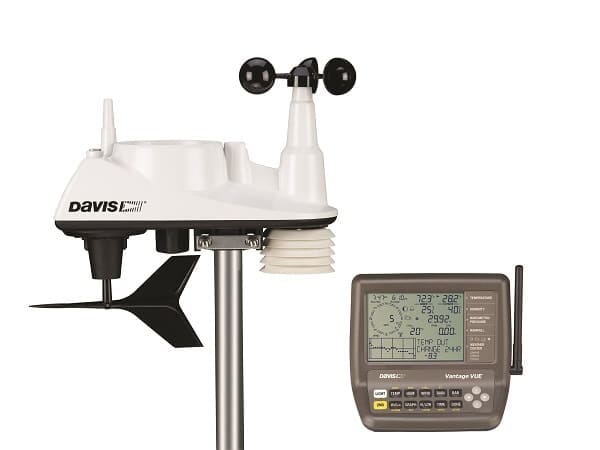How to Maintain a Davis Vantage Pro2 or Vue Weather Station

Davis are top-quality USA made weather instruments, built for long-term accuracy and reliability. However, they still benefit from a little TLC from time-to-time to help them continue to perform to their potential. Read on for tips on how to maintain and clean a Davis Vantage Vue or Davis Vantage Pro 2 Weather Station.
Anemometer
Your anemometer should provide years of service. In some areas however, spiders and insects can affect operation. If wind speed seems low, use an allen key wrench to loosen the setscrew on the side of the wind cups. Remove the wind cups, and clean the exposed portion of the shaft with a damp cloth or cotton swab. Clean the wind cups with water and a mild liquid detergent. Rinse thoroughly before replacing.
Do not use or add grease, oil, or a spray lubricant of any kind.
After replacing the wind cups and tightening the setscrew, check to make sure that the wind cups spin freely. If they do not, the bearings may be worn and unit may need replacing.
To ensure accurate wind direction readings, check the orientation of the wind vane annually. Consult your Owner's Manual for details.
External Temperature/ Humidity Sensor
Most temperature/humidity sensors do not need on-going maintenance. If you are concerned about dust build-up, remove the lower portion of the cover by loosening the two screws. Using a clean, dry toothbrush, gently brush the gold-colored mesh cloth.
Clean the white plastic cover with water and a mild liquid detergent, and rinse thoroughly before replacing.
External Temperature Sensor
Your temperature sensor should provide years of trouble-free service. It requires no on-going maintenance.
Rain Collector
For greatest accuracy, clean occasionally depending on the accumulation of dust or debris. Dust and debris can accumulate on the tipping bucket, affecting its operation. Spiders and insects can make their homes in the base, and birds have been known to nest in the funnel.
To clean the rain collector, remove the funnel from the base. Gently clean the tipping-bucket (without tipping the mechanism) and the funnel with water and a mild liquid detergent. Rinse thoroughly.
Solar Radiation Sensor
Dirt on the diffuser at the top of the sensor can affect its accuracy. As often as is practical, dust with a soft dry brush. When necessary, use a damp cloth or cotton swab dampened with methylated spirit to to clean around the rim.
UV Sensor
Dirt on the diffuser at the top of the sensor can affect its accuracy. As often as is practical, dust with a soft dry brush. When necessary, use a cloth or cotton swab dampened with methylated spirit to clean around the rim. Do not use soap or detergent.
Oil from your fingers can affect the accuracy of the readings. Do not touch the diffuser with your fingers.
Leaf Wetness Sensor
Dirt and debris on the surface of the sensor can affect its accuracy. To clean the sensor, scrub its surface with a clean toothbrush, using water and a mild liquid detergent. Rinse well.
Sensor Recalibration
Sensor readings should remain accurate within specifications for several years. However, there may be some drift over time. Generally we don't find that calibration is required, although for absolute accuracy Davis suggest that recalibration may be needed as follows:
- External Temp/Hum Sensor, five years
- Solar Radiation Sensor, four years
- UV Sensor, three years.
The External Temp/Hum Sensor may also be calibrated in the field by matching it to a reference sensor of known accuracy. Consult your Owner's Manual for details.
Recalibrating the temperature humidity sensor in the field requires a visit to site from someone with a certified accurate sensor. This would need to be a reference instrument with an annual certificate from a UKAS test house. If you need to do this then we consider that it is actually more cost-effective to replace the temperature humidity sensor with a fresh one.
The Solar and UV sensors cannot be re-calibrated in the field and would have to be returned to Davis for calibration against the original reference instruments. Against this one has to consider how much absolute accuracy is important relative to the time and cost of sending the sensors to California for recalibration.
The barometer sensors are sealed and cannot be re-calibrated. If it were possible there would be no point in sending them away for calibration as they would be affected by the journey. For these sensors, you can adjust the value at the console.
Rain collectors can be adjusted. However by the very nature of measuring rain there is a degree of subjectivity and we recommend leaving the adjustment alone. If you wish to check the measurement you can measure a small quantity of water (21.12ml approximates to 1mm of rain) and drip it through the collector. This should give 5 tips although of the mechanism although the last one may require a few extra drips to compensate for drops that stick to the surface of the cone.
The anemometer sensor is not adjustable. However so long as this rotates freely then above 5mph it should work fine. If you see a marked reduction such as no speed or flattening of the reading then it will because the reed switch has failed and the sensor should be replaced.
Also, if you have a Davis Vantage Vue, check out the video below for more specific tips on how to maintain your weather station.
View the full Davis weather range.






